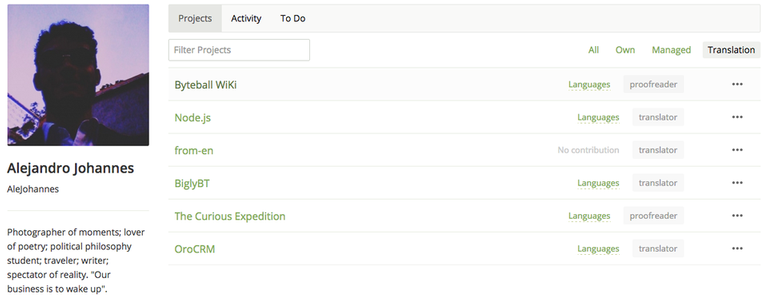Github Repository
https://github.com/nodejs/i18n
Project Details
By definition, Node.js is a Java Runtime Environment (JRE). But it is more than just that. While common JREs function as machine backups that allow users to smoothly run JavaScript on their browsers and applications, this open-source project functions as an app that manages Java code by itself. It's practical uses for developers are endless. It grants an extraordinarily versatile platform for designing code, programs, websites and other applications. And that isn't all: Node provides a virtual facility for testing the proper work of Java-driven programs and devices –and their planned updates–, helping to find bugs, solve errors, fix code and vastly improving their performance.
I believe all the amazing uses of Node are to be considered by themselves and I declare myself a fan of the project. But, besides, I support it for its functionality as a medium for bringing to reality countless creations that can be as good as Node itself. If you can dream it –and code it in JavaScript–, then your imagination is the only limit!The open translation of Node to thirty-three (33) languages proves the advantages of open-source projects when it comes to diversification of knowledge and worldwide spreading of useful tools.
Ahead, there is the link of the program's webpage:
Contribution Specifications
Translation Overview
This is my 28th contribution to Node.js as a translator. For this collaboration, I continued my previous work on the CHANGELOG_IOJS.md file, which –as its name indicates– contains the changelog of the io.js’ version of Node.
As I explained in my past translation reports, a changelog is a registry of all the changes made on determined project for each one of its versions. The files created for such purpose list modifications on internal components, substitutions of protocols, updates, deprecations, addition of supported tools, new functions, corrected errors and fixed bugs. In summary: every feature that first appeared or was removed in the program version being addressed must be specified and described in this registry. This is made with the purpose of providing a timeline of the development of the project and, by doing so, helping programmers to check any details they need to understand the way it came to be what it is and improve it in the future.
I'll refer two of the logs I translated to illustrate the dynamics of the changelog. Both of them are included in the "Commits" section of the addressed file's stable version 2.0.0. The first one goes:
There are three important concepts involved in this log and, before we can understand it, we need to address them by themselves.
The first one is "-J". Here, -J refers to the J programming language. The composition of this language is very simplistic, as it only uses the ASCII set of characters. It is specially regarded in mathematical and statistical programming, being a very versatile tool for the organization and computing of matrixes. It was firstly developed in the 90's and still continues to be one of the more widespread programming languages in the world.
The second one is ci. Here, ci is an acronym of continuous integration. Continuous integration is the process through which the constant updates being applied to an specific program are made effective almost instantly. Many projects that need the assistance of users to detect bugs and keep growing and getting better depend on the success of continuous integration. A flaky integration process leads to a flaky program, since the wrong components become substituted, data comes overwritten by error and ambiguous instructions become effective when old and new directrices come active at the same time. It is, then, understandable that continuous integration tests are a big deal for this kind of programs. For your imagination to have an image, I'll tell you that a good continuous integration configuration looks a lot like Saturday Night Live's Closet Organizer, placing the changes right where they should be:
Having the aforementioned terms explained, we can understand that, with this commit, the developers seek to increase the performance of the continuous integration test of Node.js, by having an unneeded check of the use of the J programming language removed of its process.
The second log I'll refer is this one:
This one is quite simple, we just need to understand what is npm. NPM stands for Node.js' Package Manager, and what it does is exactly that: unboxing data packages that are added to the environment of Node.js in a safe, bug-proofed, way, so the contents of those go to the virtual locations that require them and can actually build modules (their main use) in Node with them. It came online with Node itself in 2010 and its latest stable version (6.5.0) was released less than a month ago. What this commit proposes is clear as water: updating NPM to its version 2.9.0, the newer at that time.
You can check some references here for more information about the previously addressed concepts:
- http://www.jsoftware.com/
- https://rosettacode.org/wiki/Category:J
- https://en.wikipedia.org/wiki/J_(programming_language)
- https://www.techopedia.com/definition/24368/continuous-integration-ci
- https://codeship.com/continuous-integration-essentials
- https://en.wikipedia.org/wiki/Continuous_integration
- https://www.npmjs.com/
- https://www.w3schools.com/nodejs/nodejs_npm.asp
- https://en.wikipedia.org/wiki/Npm_(software)
All changes included in each one of the versions of the project are formatted as pull-request commits. Id est, they are presented as very brief comments about the action that was suggested, are normally written with imperative verbs, and have a strict limitation on their number of characters (so even complex ideas are reduced to a small amount of words). These specifications made the translation of this document a challenge. However, it was satisfactorily achieved. As you will see in the examples below, the name of the developer who provided each log is often referred inside parenthesis at the end of it.
Work example #01:
English:
[<0>db4ded5903</0>] - <1>deps</1>: enable v8 postmortem debugging again (Ben Noordhuis) <2>#1232</2>
Spanish:
[<0>db4ded5903</0>] - <1>deps</1>: volver a habilitar la depuración postmortem de v8 (Ben Noordhuis) <2>#1232</2>
Work example #02:
English:
[<0>2a3a1909ab</0>] - <1>doc</1>: add require() lines to child.stdio example (Nick Raienko) <2>#1504</2>
Spanish:
[<0>2a3a1909ab</0>] - <1>doc</1>: añadir líneas de require() al ejemplo de child.stdio (Nick Raienko) <2>#1504</2>
Work example #03:
English:
[<0>f9c681cf62</0>] - <1>fs</1>: validate fd on fs.write (Julian Duque) <2>#1553</2>
Spanish:
[<0>f9c681cf62</0>] - <1>fs</1>: validar el descriptor de archivos en fs.write (Julian Duque) <2>#1553</2>
Languages
This translation was made from English to Spanish.
I got plenty experience translating and proofreading this project as an Utopian contributor. I collaborate here as translator and Language Moderator of the Da-Vinci/Utopian Spanish translation team. Besides this project, I have experience translating and proofreading The Curious Expedition, Ancap-ch, Byteball Wiki, OroCrm and BiglyBT.
Word Count
- The amount of words translated in this contribution is: 1,872.
- The total amount of words translated in this project (as a Da-vinci/Utopian translator) is: 34,517.
Previous Translations of the Project
- Contribution N'01. Submitted on September 13th, 2018.
- Contribution N'02. Submitted on September 15th, 2018.
- Contribution N'03. Submitted on September 17th, 2018.
- Contribution N'04. Submitted on September 19th, 2018.
- Contribution N'05. Submitted on September 21th, 2018.
- Contribution N'06. Submitted on September 22th, 2018.
- Contribution N'07. Submitted on September 23th, 2018.
- Contribution N'08. Submitted on October 1st, 2018.
- Contribution N'09. Submitted on October 8th, 2018.
- Contribution N'10. Submitted on October 14th, 2018.
- Contribution N'11. Submitted on October 15th, 2018.
- Contribution N'12. Submitted on October 18th, 2018.
- Contribution N'13. Submitted on October 21st, 2018.
- Contribution N'14. Submitted on October 24th, 2018.
- Contribution N'15. Submitted on October 27th, 2018.
- Contribution N'16. Submitted on October 31th, 2018.
- Contribution N'17. Submitted on November 3rd, 2018.
- Contribution N'18. Submitted on November 4th, 2018.
- Contribution N'19. Submitted on November 6th, 2018.
- Contribution N'20. Submitted on November 17th, 2018.
- Contribution N'21. Submitted on November 24th, 2018.
- Contribution N'22. Submitted on December 7th, 2018.
- Contribution N'23. Submitted on December 15th, 2018.
- Contribution N'24. Submitted on December 20th, 2018.
- Contribution N'25. Submitted on December 26th, 2018.
- Contribution N'26. Submitted on December 28th, 2018.
- Contribution N'27. Submitted on December 30th, 2018.
Proof of Authorship
This translation was made January 5th. You can check the translation record in my Crowdin account [here], the activity on the project's Crowdin [here] and a summary of recent additions to the project [here].






Hi @alejohannes,
Hurray! This is your 28th contribution to Node.js.
This is a very interesting project that contains many code values and terms related to computer science. Its difficulty relies on the fact that we must pay a lot of attention to the code in order to deliver the most accurate translation possible.
Your presentation posts are always fun and easy to read and this one it's not the exception. It is very well written and formatted, includes all the basic details, as well as your personal feedback.
Thank you for sharing clear and precise concepts you learned while working on this contribution.
Once again, you delivered an accurate translation. You used the correct vocabulary and you were careful with code values that should not be translated in order to make sure the text keeps its true meaning.
Your contribution has been evaluated according to Utopian policies and guidelines, as well as a predefined set of questions pertaining to the category.
To view those questions and the relevant answers related to your post, click here.
Chat with us on Discord
Thank you for your review, @marugy99! Keep up the good work!
Congratulations @alejohannes! You have completed the following achievement on the Steem blockchain and have been rewarded with new badge(s) :
Click here to view your Board
If you no longer want to receive notifications, reply to this comment with the word
STOPDo not miss the last post from @steemitboard:
Hi @alejohannes!
Your post was upvoted by @steem-ua, new Steem dApp, using UserAuthority for algorithmic post curation!
Your post is eligible for our upvote, thanks to our collaboration with @utopian-io!
Feel free to join our @steem-ua Discord server
Hey, @alejohannes!
Thanks for contributing on Utopian.
We’re already looking forward to your next contribution!
Get higher incentives and support Utopian.io!
Simply set @utopian.pay as a 5% (or higher) payout beneficiary on your contribution post (via SteemPlus or Steeditor).
Want to chat? Join us on Discord https://discord.gg/h52nFrV.
Vote for Utopian Witness!